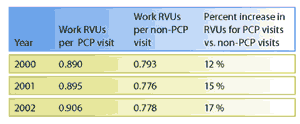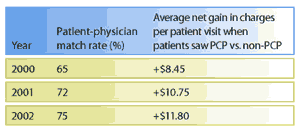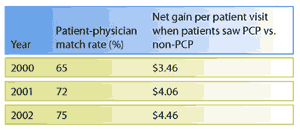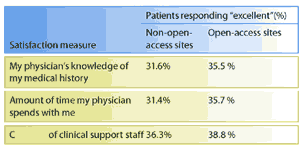
Good things happen when patients are seen "today" by their own physicians.
Fam Pract Manag. 2004;11(2):35-38

The dance continues week after week in medical practices across the country: Patients call with unpredictable needs. Schedulers work some into slots weeks or months in the future and pass others with more urgent needs along to nurses, who shuffle around the day’s schedule to squeeze in a few more appointments. Physicians shrink their lunches and bump back their dinners to accommodate demand, only to find it makes no long-term difference in their workloads.
One way to control the dance and decrease the backlog of appointments is through open-access scheduling. With open access, patients are seen on the day they call for an appointment regardless of the reason for their visit. We began to use open-access scheduling at Allina Medical Clinic (AMC) in 1999 and were surprised to find it had more far-reaching effects than simply reducing the appointment backlog and improving patient satisfaction scores. For us, open access resulted in better-compensated physicians who provide additional services to patients, a more efficient clinical environment that generates higher net gains, and happier patients who are more likely to have established relationships with their primary care physicians (PCPs).
A bit of background
The AMC delivers primary and specialty health care to more than 500,000 patients annually at 40 locations throughout Minnesota, with clinics ranging in size from four to more than 80 physicians. When we announced plans to launch open access at 12 pilot sites in the system, many physicians voiced concern. They predicted open access would be difficult to implement at clinics so diverse in size and among physicians with such varied practice styles. While they welcomed improving continuity of care by matching and scheduling patients with their PCPs, they worried about the effect it would have on their bottom line. According to the literature, clinics that routinely schedule patients with their PCPs can reduce demand for office visits by 10 percent.1 That's not exactly welcome news to physicians whose compensation is based on the number of services they provide.
KEY POINTS
Allina Medical Clinic found that open-access scheduling has done much more than reduce patient wait times for appointments.
Matching and scheduling patients with their primary care physician (a key component of open access) actually increased both quality of care and revenue.
Other outcomes included improved continuity of care, more productive patient visits, higher physician compensation and higher net gains for clinics.
Preparing for the launch
While this article focuses on outcomes, those interested in learning about implementing open access can begin by reading "Same-day Appointments: Exploding the Access Paradigm" (FPM, September 2000:45-50) written by open-access creators Mark Murray, MD, and Catherine Tantau, RN, MS (see tips excerpted from the article below). Basically, implementing open access requires an overhaul of scheduling infrastructure. This includes decreasing appointment types, simplifying operational processes, using past appointment requests to predict future demand and developing contingency plans for times when demand exceeds prediction.
To track the effects of open-access scheduling, our data warehouse collected coding information on every patient visit at 23 AMC locations for three years (prior to, during and after our launch of open access). We also asked the data warehouse to provide baseline data on average visit charges per clinic as well as per physician.
To determine current patient-physician match levels, we pulled 18 months of patient-visit histories and conducted a telephone survey asking patients to identify their PCP. To match patients with their PCPs, we created an algorithm that considered factors such as who patients had seen most frequently in the past two years for preventive care visits as well as those physicians’ specialties.
While the actual implementation process and timetables varied widely among the pilot sites, the individualized and collective data supplied by the data warehouse provided the bedrock for each plan. During implementation, the extensive baseline data became building blocks for prediction algorithms that helped clinics anticipate demand. After implementation, the growing body of documented outcomes helped convince physicians at other clinics to start down the path toward open access.
OPEN ACCESS TIPS
Open-access (or advanced-access) scheduling involves “doing today’s work today” and seeing patients on the day they call for an appointment. Mark Murray, MD, and Catherine Tantau, RN, MS, creators of the open-access model, offer these tips for success:
Move toward advanced access by working down your backlog of appointments.
Roll out the new system by showing, not telling, patients how it works. When we try to explain our systems, we often make them overly complicated.
Begin offering all patients an appointment on the day they call your office, regardless of the reason for the visit.
If patients do not want to be seen on the day they call, schedule an appointment of their choosing. Do not tell them to call back on the day they want to be seen.
Allow physicians to pre-schedule patients when it is clinically necessary (“good backlog”).
Reduce the complexity of your scheduling system to just three kinds of appointments (personal, team and unestablished) and one standard length of time.
Make sure each physician has a panel size that is manageable, based on his or her scope of practice, patient mix and time spent in the office.
Encourage efficiency and continuity by protecting physicians’ schedules from their colleagues’ overflow.
Develop plans for how your practice will handle times of extreme demand or physician absence.
Reduce future demand by maximizing today’s visit.
Outcomes data
With the help of an information services team, project managers worked with each pilot site to automate the tracking of several key open-access indicators, including panel count, appointment demand, provider capacity, patient-to-PCP match and patient visits. Sites received monthly panel reports detailed for each provider. Using this data we were able to determine that open-access scheduling resulted in the following:
More patients seeing their own physician. The telephone survey we conducted prior to implementing open access revealed that 55 percent of our patients could not or would not identify a PCP. We hypothesized that some patients may not have identified a PCP intentionally, having learned that they could be seen more quickly if they were more flexible about who they saw. When we launched open access, we instructed schedulers and physicians to verbally reinforce patient-physician matches each time a patient contacted or visited the office. For example, when a patient saw a physician who was not his or her PCP, the physician would begin the visit by saying, “Hello, I am Dr. Jones. I know you are a patient of Dr. Smith’s, but I’ll be seeing you today.” As patients began to realize that identifying a PCP wasn’t impeding their ability to be seen promptly, the number of patients volunteering the names of their PCPs changed dramatically. At one pilot clinic, the percentage of patients who asked for a physician by name jumped from 45 percent to 81 percent.
Patient-physician matches steadily increased after we launched open access in 1999. In 2000, patients’ PCPs cared for them at 65 percent of office visits. Two years later, that number jumped to 75 percent. Quality of care improved along with continuity: 18 percent of office visits at the open-access sites included preventive care compared with 13 percent of visits at the other AMC sites.
More robust patient visits. The more often schedulers were able to match patients with their PCPs, the more productive the visits became. We discovered that as physicians and patients developed their relationships, patients became more comfortable asking for needed services and were also more accepting of recommendations that they receive other services. Because physicians were familiar with these patients and had designed health care strategies for them, they were also more likely to have the time to perform these extra services. As more physicians saw their own patients and as services and efficiencies increased, so did revenues per patient visit.
While AMC physicians had initially worried that implementing open access could potentially reduce patient demand for their services, the data actually show that although the number of visits per patient dropped from 2.82 in January 2001 to 2.64 in December 2002, the amount of work provided per visit increased, generating more revenue (see “Improved RVUs”).
IMPROVED RVUs
Under Allina Medical Clinic’s open-access system, RVUs (relative value units) per patient visit were higher when patients saw their own primary care physician (PCP), while RVUs at non-PCP visits essentially remained flat. Data from 2003 indicate this trend continues.

IMPROVED CLINIC CHARGES
Under Allina Medical Clinic’s open-access system, average net charges per patient visit increased as more patients saw their own primary care physician (PCP).

Increased physician compensation. While our original goal was to match patients and PCPs to improve service and quality of care, the stronger patient-physician relationships that resulted also led to increased compensation for physicians. In the first year after implementation of open access, charges for visits at which patients saw their PCPs were 12 percent higher than charges for visits with a non-PCP (see “Improved physician compensation”). In 2002, charges at PCP visits were 16.5 percent higher than at non-PCP visits, resulting in an additional $4.46 in physician compensation per PCP-visit.
Higher net gains for clinics. As more patients were matched with their own PCP and as physicians began to provide more robust visits as a way to reduce future demand, overall clinic charges improved. In 2000, for example, the overall patient-PCP match averaged 65 percent and charges averaged $8.45 more per visit than for non-PCP visits. In 2002, pilot sites averaged a patient-PCP match of 75 percent and charges for PCP vs. non-PCP visits increased $11.80 per visit.
More efficient clinic operations. Open access showed us how much of an access barrier triage had become to patients who wanted to see a physician. As a result, we’ve reduced our number of full-time-equivalent triage nurses. Despite that, physicians report more efficient use of their time under open access. For example, they say they spend less time reviewing unfamiliar medical histories because they see more of their own patients.
Decreased use of urgent-care services. Experiential data showed that patients at the 12 pilot sites used fewer urgent care services. At one pilot clinic physicians are scheduled until 8 p.m. several times a week. Prior to launching open access, the evening appointments were filled with urgent care appointments made by patients who couldn’t get an appointment during regular office hours. Now, patients with urgent needs can see their own physicians during the day, and evening time slots are used by patients who find them more convenient.
Improved patient satisfaction. When compared with other clinics in the AMC system, the open-access sites scored higher on 12 measures of patient satisfaction (see “Improved patient satisfaction scores”). For example, patients at the pilot sites were more likely to identify their PCP, to rate their physician’s knowledge of their medical history as “excellent,” to rate the amount of time their physician spent with them as “excellent” and to say they could get an appointment when they wanted one.
IMPROVED PHYSICIAN COMPENSATION
While Allina Medical Clinic’s primary goal was to improve service and quality of care by matching patients with primary care physicians (PCPs), the improved relationships that resulted also led to better compensated physicians.

IMPROVED PATIENT SATISFACTION SCORES
The table below shows a few examples of the effect open-access scheduling had on patient satisfaction scores within the Allina Medical Clinic system.

The payoff continues
Thanks to the work of the 12 pilot sites, other clinics in the AMC system are now eagerly following their lead. Currently all but three of our primary care and ob/gyn sites have launched open access and we have now begun the implementation process at our specialty care sites.
While we continue to monitor the original pilot clinics, the transition to open access has gone so well there that staff and physicians have moved on to other operational goals. That’s not to say that the busy dance of answering calls, scheduling visits and providing clinical care doesn’t continue at these clinics; it does, but at a much calmer pace. The phones are quieter, and schedulers, nurses, physicians and staff spend much less time in the backlog shuffle, leaving more time to care for patients.